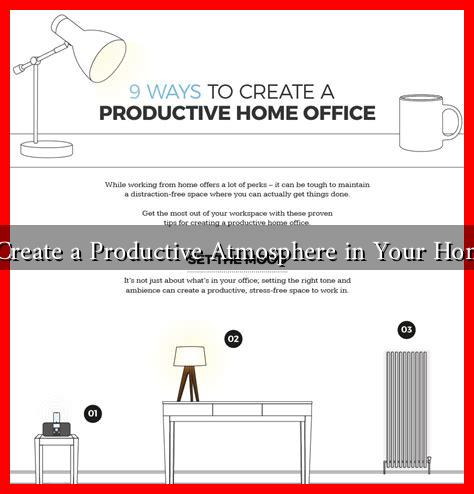-
Table of Contents
- How to Create a Productive Atmosphere in Your Home Office
- Understanding the Importance of a Productive Atmosphere
- Key Elements of a Productive Home Office
- Creating a Distraction-Free Environment
- Incorporating Technology Wisely
- Case Study: Successful Home Office Transformations
- Conclusion: Crafting Your Ideal Workspace
How to Create a Productive Atmosphere in Your Home Office
As remote work becomes increasingly common, creating a productive atmosphere in your home office is essential for maintaining focus and efficiency. A well-designed workspace can significantly impact your productivity, mental well-being, and overall job satisfaction. In this article, we will explore various strategies to enhance your home office environment, supported by research and practical examples.
Understanding the Importance of a Productive Atmosphere
Research indicates that the environment in which you work can influence your performance. According to a study published in the Journal of Environmental Psychology, individuals working in well-designed spaces reported higher levels of satisfaction and productivity. A productive atmosphere not only fosters creativity but also reduces stress and distractions.
Key Elements of a Productive Home Office
To create a conducive workspace, consider the following elements:
- Ergonomic Furniture: Invest in a comfortable chair and desk that promote good posture. Ergonomic furniture can reduce physical strain and enhance focus.
- Lighting: Natural light is ideal for productivity. Position your desk near a window or use full-spectrum bulbs to mimic daylight.
- Color Psychology: Colors can affect mood and productivity. For instance, blue hues are known to enhance focus, while green can promote creativity.
- Decluttered Space: A tidy workspace minimizes distractions. Regularly organize your desk and remove unnecessary items.
- Personal Touches: Incorporate elements that inspire you, such as artwork, plants, or motivational quotes.
Creating a Distraction-Free Environment
Distractions can severely hinder productivity. Here are some strategies to minimize interruptions:
- Set Boundaries: Communicate with family members or roommates about your work hours to minimize disruptions.
- Use Noise-Canceling Headphones: These can help block out background noise, allowing you to concentrate better.
- Establish a Routine: A consistent daily schedule can help signal to your brain when it’s time to work and when it’s time to relax.
Incorporating Technology Wisely
Technology can be both a boon and a bane in a home office. Here’s how to use it effectively:
- Productivity Tools: Utilize apps like Trello or Asana to manage tasks and deadlines efficiently.
- Time Management Techniques: Consider the Pomodoro Technique, which involves working for 25 minutes followed by a 5-minute break, to maintain focus.
- Virtual Collaboration Tools: Use platforms like Zoom or Slack to stay connected with colleagues and foster teamwork.
Case Study: Successful Home Office Transformations
Many professionals have successfully transformed their home offices into productive spaces. For example, a survey conducted by Buffer in 2021 revealed that 98% of remote workers would like to work remotely at least some of the time for the rest of their careers. Those who reported higher productivity levels often cited a well-organized and personalized workspace as a key factor.
Another case is that of Sarah, a freelance graphic designer, who revamped her home office by incorporating ergonomic furniture and vibrant colors. She reported a 30% increase in her productivity after making these changes, attributing her success to the improved atmosphere.
Conclusion: Crafting Your Ideal Workspace
Creating a productive atmosphere in your home office is not just about aesthetics; it’s about fostering an environment that enhances focus, creativity, and well-being. By investing in ergonomic furniture, optimizing lighting, minimizing distractions, and leveraging technology, you can significantly improve your work experience.
Remember, the key takeaways are:
- Prioritize ergonomic furniture and proper lighting.
- Minimize distractions by setting boundaries and establishing a routine.
- Utilize technology to enhance productivity, not hinder it.
By implementing these strategies, you can create a home office that not only meets your professional needs but also supports your overall health and happiness. For more tips on enhancing your workspace, check out resources like Harvard Business Review.




